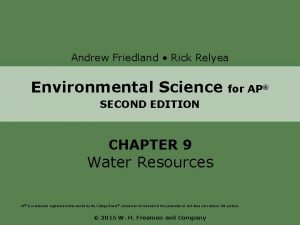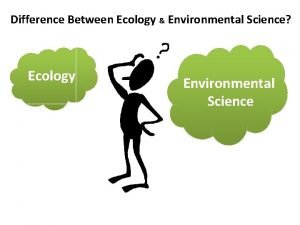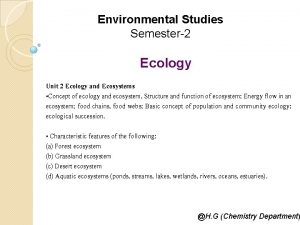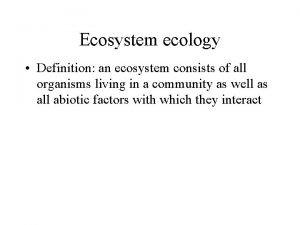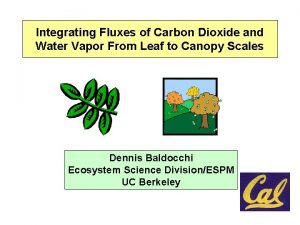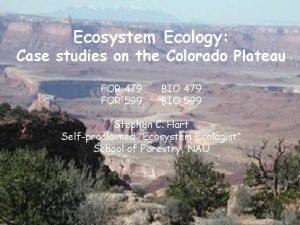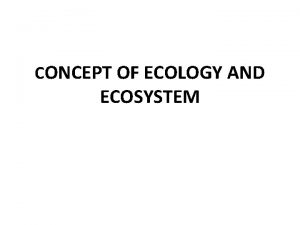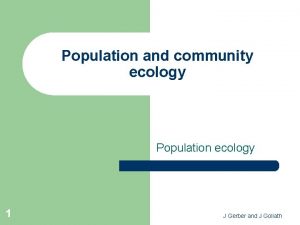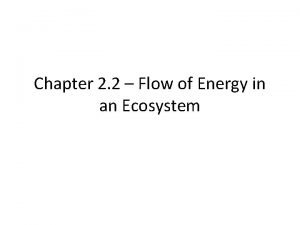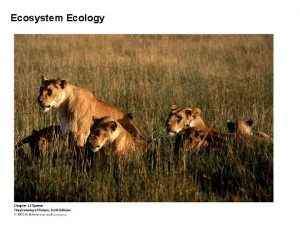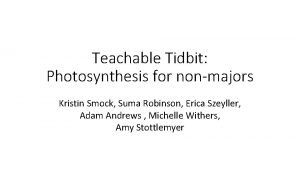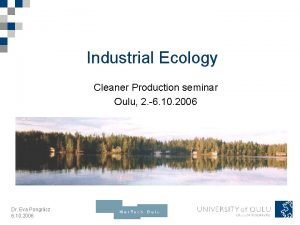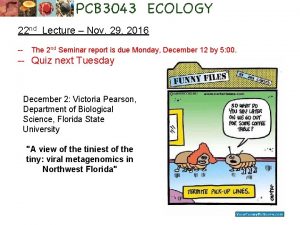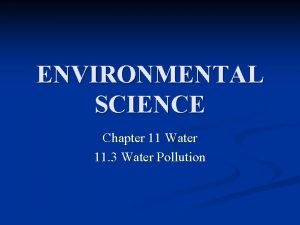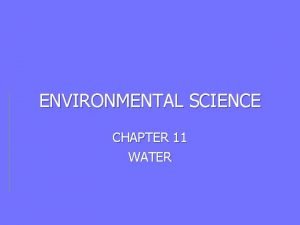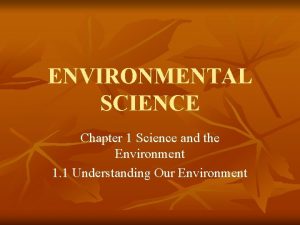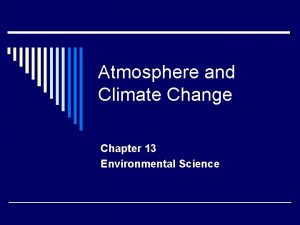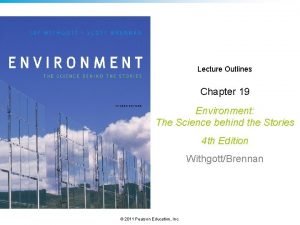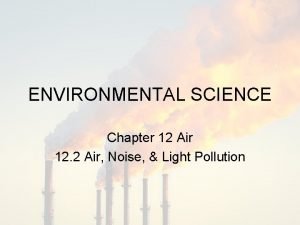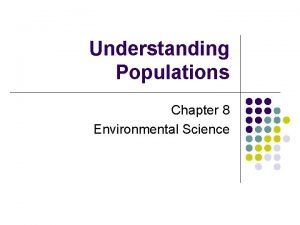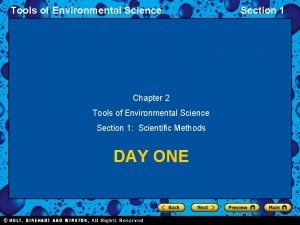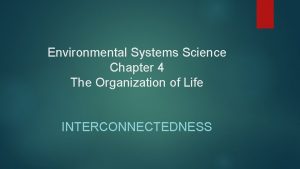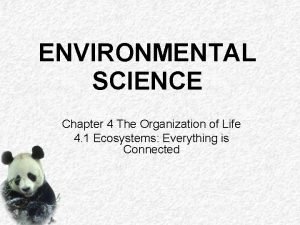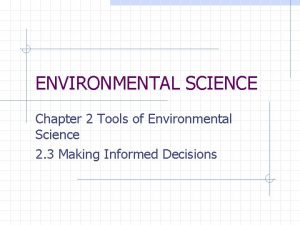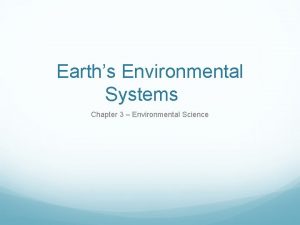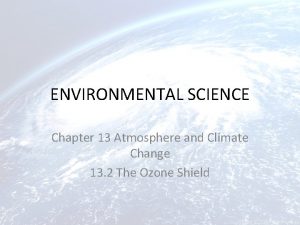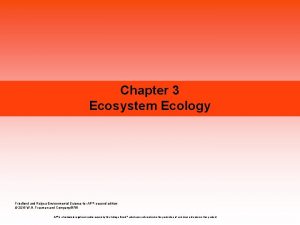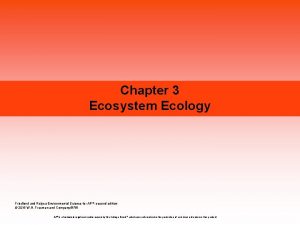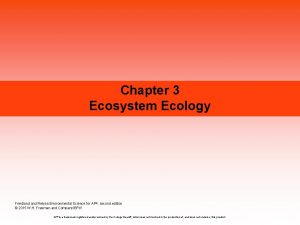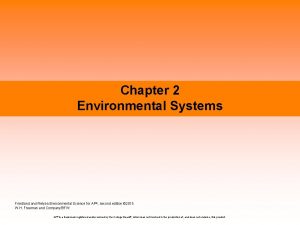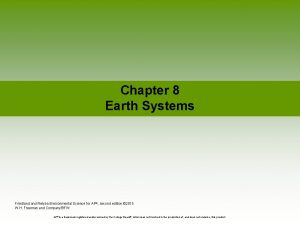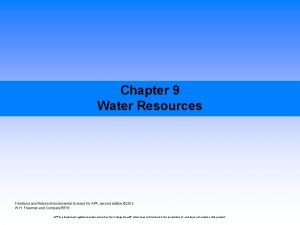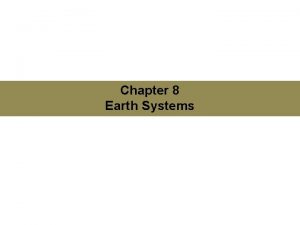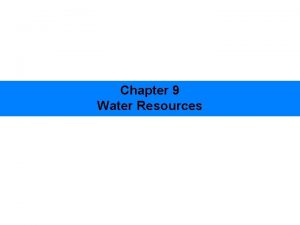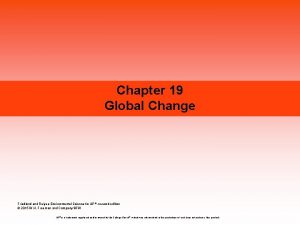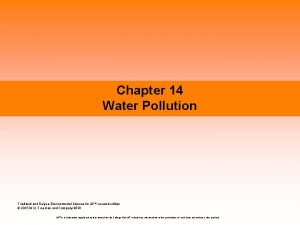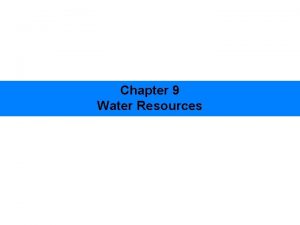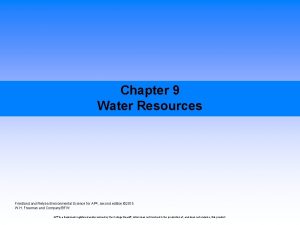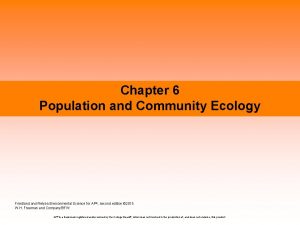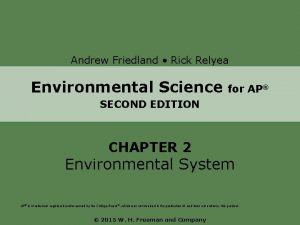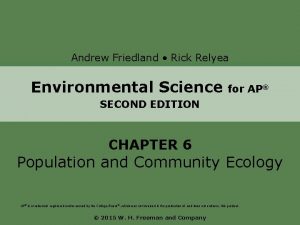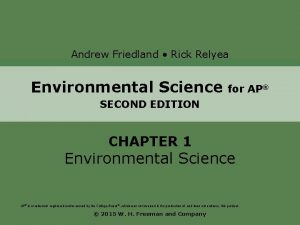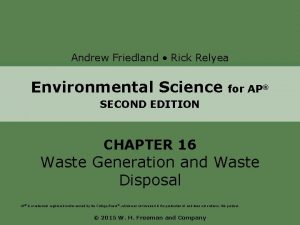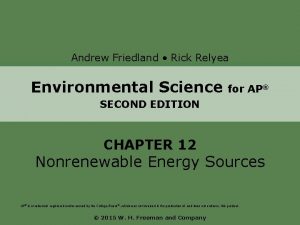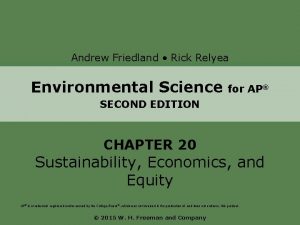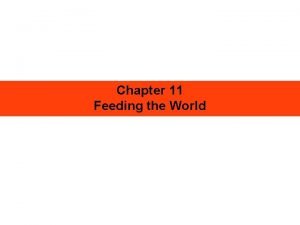Chapter 3 Ecosystem Ecology Friedland Relyea Environmental Science


































- Slides: 34

Chapter 3 Ecosystem Ecology Friedland Relyea Environmental Science for AP®, second edition © 2015 W. H. Freeman and Company/BFW AP® is a trademark registered and/or owned by the College Board®, which was not involved in the production of, and does not endorse, this product.

Module 6 The Movement of Energy After reading this module you should be able to • explain the concept of ecosystem boundaries. • describe the processes of photosynthesis and respiration. • distinguish among the trophic levels that exist in food chains and food webs. • quantify ecosystem productivity. • explain energy transfer efficiency and trophic pyramids.

Ecosystem boundaries are not clearly defined • Some ecosystems, such as a caves and lakes, have very distinctive boundaries. However, in most ecosystems it is difficult to determine where one ecosystems stops and the next begins. • Even though it is helpful to distinguish between two different ecosystems, ecosystems interact with other ecosystems. • Biosphere The region of our planet where life resides; the combination of all ecosystems on Earth.

Ecosystem Boundaries Large and small ecosystems. (a) The Greater Yellowstone Ecosystem includes the land within Yellowstone National Park and many adjacent properties. (b) Some ecosystems are very small, such as a rain-filled tree hole that houses a diversity of microbes and aquatic insects.

Photosynthesis captures energy and respiration releases energy • Producer An organism that uses the energy of the Sun to produce usable forms of energy. Also known as Autotroph. • Photosynthesis The process by which producers use solar energy to convert carbon dioxide and water into glucose. • Cellular respiration The process by which cells unlock the energy of chemical compounds. • Aerobic respiration The process by which cells convert glucose and oxygen into energy, carbon dioxide, and water. • Anaerobic respiration The process by which cells convert glucose into energy in the absence of oxygen.

Photosynthesis and Respiration Photosynthesis and respiration. Photosynthesis is the process by which producers use solar energy to convert carbon dioxide and water into glucose and oxygen. Respiration is the process by which organisms convert glucose and oxygen into water and carbon dioxide, releasing the energy needed to live, grow, and reproduce. All organisms, including producers, perform respiration.

Energy captured by producers moves through many trophic levels • Consumer An organism that is incapable of photosynthesis and must obtain its energy by consuming other organisms. Also known as Heterotroph. • Herbivore A consumer that eats producers. Also known as Primary consumer. • Carnivore A consumer that eats other consumers. • Secondary consumer A carnivore that eats primary consumers. • Tertiary consumer A carnivore that eats secondary consumers. • Trophic levels The successive levels of organisms consuming one another. • Food chain The sequence of consumption from producers through tertiary consumers.

Trophic Levels Simple food chains. A simple food chain that links producers and consumers in a linear fashion illustrates how energy and matter move through the trophic levels of an ecosystem. (a) An example of a terrestrial food chain. (b) An example of an aquatic food chain.

Trophic levels • Food web A complex model of how energy and matter move between trophic levels. • Scavenger An organism that consumes dead animals. • Detritivore An organism that specializes in breaking down dead tissues and waste products into smaller particles. • Decomposers Fungi and bacteria that convert organic matter into small elements and molecules that can be recycled back into the ecosystem.

Trophic Levels A simplified food web. Food webs are more realistic representations of trophic relationships than simple food chains. They include scavengers, detritivores, and decomposers, and they recognize that some species feed at multiple trophic levels. Arrows indicate the direction of energy movement. This is a real but somewhat simplified food web; in an actual ecosystem, many more organisms are present. In addition, there are many more energy movements.

Some ecosystems are more productive than others • Gross primary productivity (GPP) The total amount of solar energy that producers in an ecosystem capture via photosynthesis over a given amount of time. • Net primary productivity (NPP) The energy captured by producers in an ecosystem minus the energy producers respire.

Ecosystem Productivity Gross and net primary productivity. Producers typically capture only about 1 percent of available solar energy via photosynthesis. This is known as gross primary productivity, or GPP. About 60 percent of GPP is typically used for respiration. The remaining 40 percent of GPP is used for the growth and reproduction of the producers. This is known as net primary productivity, or NPP.

The efficiency of energy transfer affects the energy present in each trophic level • Biomass The total mass of all living matter in a specific area. • Standing crop The amount of biomass present in an ecosystem at a particular time. • Ecological efficiency The proportion of consumed energy that can be passed from one trophic level to another. • Trophic pyramid A representation of the distribution of biomass, numbers, or energy among trophic levels.

Ecosystem Efficiency Trophic pyramid for the Serengeti ecosystem. The amount of energy that is present at each trophic level is shown in joules (J). The pyramid assumes 10 percent ecological efficiency, but efficiencies can range from 5 to 20 percent across different ecosystems. For most ecosystems, graphing the numbers of individuals or biomass within each trophic level would produce a similar pyramid.

Module 7 The Movement of Matter After reading this module you should be able to • describe how water cycles within ecosystems. • explain how carbon cycles within ecosystems. • describe how nitrogen cycles within ecosystems. • explain how phosphorus cycles within ecosystems. • discuss the movement of calcium, magnesium, potassium, and sulfur within ecosystems.

The hydrologic cycle moves water through the biosphere • Biogeochemical cycle The movements of matter within and between ecosystems. • Hydrologic cycle The movement of water through the biosphere.

The Hydrologic Cycle The hydrologic cycle. Water moves from the atmosphere to Earth’s surface and back to the atmosphere.

The Hydrologic Cycle • Transpiration The release of water from leaves during photosynthesis. • Evapotranspiration The combined amount of evaporation and transpiration. • Runoff Water that moves across the land surface and into streams and rivers.

The carbon cycle moves water between air, water, and land • Carbon cycle The movement of carbon around the biosphere.

The Carbon Cycle The carbon cycle. Producers take up carbon from the atmosphere via photosynthesis and pass it on to consumers and decomposers. Some inorganic carbon sediments out of the water to form sedimentary rock while some organic carbon may be buried and become fossil fuels. Respiration by organisms returns carbon to the atmosphere and water. Combustion of fossil fuels and other organic matter returns carbon to the atmosphere.

The nitrogen cycle includes many chemical transformations • Macronutrient One of six key elements that organisms need in relatively large amounts: nitrogen, phosphorus, potassium, calcium, magnesium, and sulfur. • Limiting nutrient A nutrient required for the growth of an organism but available in a lower quantity than other nutrients. • Nitrogen cycle The movement of nitrogen around the biosphere.

The Nitrogen Cycle • Nitrogen fixation A process by which some organisms can convert nitrogen gas molecules directly into ammonia. • Nitrification The conversion of ammonia (NH 4+) into nitrite (NO 2– ) and then into nitrate (NO 3– ). • Assimilation The process by which producers incorporate elements into their tissues.

The Nitrogen Cycle • Mineralization The process by which fungal and bacterial decomposers break down the organic matter found in dead bodies and waste products and convert it into inorganic compounds. • Ammonification The process by which fungal and bacterial decomposers break down the organic nitrogen found in dead bodies and waste products and convert it into inorganic ammonium (NH 4+). • Denitrification The conversion of nitrate (NO 3– ) in a series of steps into the gases nitrous oxide (N 2 O) and, eventually, nitrogen gas (N 2), which is emitted into the atmosphere. • Leaching The transportation of dissolved molecules through the soil via groundwater.

The Nitrogen Cycle The nitrogen cycle moves nitrogen from the atmosphere and into soils through several fixation pathways, including the production of fertilizers by humans. In the soil, nitrogen can exist in several forms. Denitrifying bacteria release nitrogen gas back into the atmosphere.

The phosphorus cycle moves between land water • Phosphorus cycle The movement of phosphorus around the biosphere. • Algal bloom A rapid increase in the algal population of a waterway. • Hypoxic Low in oxygen.

The Phosphorus Cycle The phosphorus cycle begins with the weathering or mining of phosphate rocks and use of phosphate fertilizer, which releases phosphorus into the soil and water. This phosphorus can be used by producers and subsequently moves through the food web. In water, phosphorus can precipitate out of solution and form sediments, which over time are transformed into new phosphate rocks.

Calcium, magnesium, potassium, and sulfur also cycle in ecosystems • Sulfur cycle The movement of sulfur around the biosphere.

The Sulfur Cycle The sulfur cycle. Most sulfur exists as rocks. As these rocks are weathered over time, they release sulfate ions (SO 42− ) that producers can take up and assimilate. This assimilated sulfur then passes through the food web. Volcanoes, the burning of fossil fuels, and the mining of copper put sulfur dioxide (SO 2) into the atmosphere. In the atmosphere, sulfur dioxide combines with water to form sulfuric acid (H 2 SO 4). This sulfuric acid is carried back to Earth when it rains or snows.

Module 8 Responses to Disturbances After reading this module you should be able to • distinguish between ecosystem resistance and ecosystem resilience. • explain the insights gained from watershed studies. • explain the intermediate disturbance hypothesis.

Ecosystems are affected differently by disturbance and in how well they bounce back after the disturbance • Disturbance An event, caused by physical, chemical, or biological agents, resulting in changes in population size or community composition. • Resistance A measure of how much a disturbance can affect flows of energy and matter in an ecosystem. • Resilience The rate at which an ecosystem returns to its original state after a disturbance. • Restoration ecology The study and implementation of restoring damaged ecosystems.

Watershed studies help us understand how disturbances affect ecosystem processes • Watershed All land in a given landscape that drains into a particular stream, river, lake, or wetland.

Watershed Studies Watershed. A watershed is the area of land that drains into a particular body of water.

Intermediate levels of disturbance favor high species diversity • Intermediate disturbance hypothesis The hypothesis that ecosystems experiencing intermediate levels of disturbance are more diverse than those with high or low disturbance levels.

Intermediate disturbance hypothesis. (a) In general, we expect to see the highest species diversity at intermediate levels of disturbance. Rare disturbances favor the best competitors, which outcompete other species. Frequent disturbances eliminate most species except those that have evolved to live under such conditions. At intermediate levels of disturbance, species from both extremes can persist. (b) An example of the intermediate disturbance in the number of algal species observed in response to different amounts of herbivory by marine snails. When few or many snails are present, there is a low diversity of algal species, but when an intermediate density of snails are consuming algae, the snails cause an intermediate amount of disturbance and a higher diversity of algal species can persist in the ecosystem.
 Friedland and relyea environmental science
Friedland and relyea environmental science Rick relyea
Rick relyea Difference of ecology and environmental science
Difference of ecology and environmental science Liz friedland
Liz friedland Medienkonzepte friedland
Medienkonzepte friedland Difference between ecosystem and ecology
Difference between ecosystem and ecology An ecosystem consists of
An ecosystem consists of Ecosystem ecology
Ecosystem ecology Ecology and ecosystem
Ecology and ecosystem Difference between ecosystem and ecology
Difference between ecosystem and ecology Ecosystem ecology
Ecosystem ecology Principles of ecology 2 flow of energy in an ecosystem
Principles of ecology 2 flow of energy in an ecosystem Ecosystem ecology
Ecosystem ecology Ecosystem ecology
Ecosystem ecology Ecology ecosystem
Ecology ecosystem Ecosystem ecology
Ecosystem ecology Rule of 70 population growth
Rule of 70 population growth Chapter 4 section 1 population dynamics answer key
Chapter 4 section 1 population dynamics answer key My favourite subject is science
My favourite subject is science Ap environmental science chapter 11
Ap environmental science chapter 11 Water that contains wastes from homes or industry
Water that contains wastes from homes or industry Environmental science chapter
Environmental science chapter Environmental science chapter 13
Environmental science chapter 13 Chapter 19 environmental science
Chapter 19 environmental science Chapter 2 economics and environmental policy
Chapter 2 economics and environmental policy Radonrid
Radonrid Chapter 8 environmental science
Chapter 8 environmental science Tools of environmental science
Tools of environmental science The day they parachuted cats into borneo food web
The day they parachuted cats into borneo food web Environmental science chapter 4 the organization of life
Environmental science chapter 4 the organization of life Chapter 2 environmental science
Chapter 2 environmental science Environmental science chapter 3
Environmental science chapter 3 Environmental science chapter 10 review answers
Environmental science chapter 10 review answers Limestone ridges built by tiny animals
Limestone ridges built by tiny animals Chapter 13 environmental science
Chapter 13 environmental science
